What is POI: Understanding Point of Interest Data for Analysts
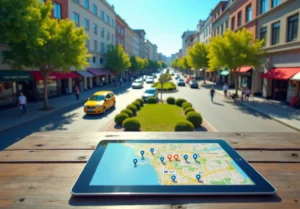
What is POI: Understanding Point of Interest Data for Analysts
Overview
Point of Interest (POI) data encompasses vital information regarding significant locations, including businesses and public spaces. Analysts leverage this data for urban planning and marketing strategies, making it an indispensable resource. Understanding POI data is essential for informed decision-making; it enables businesses to pinpoint market opportunities while facilitating urban development through effective utilization of location insights.
The features of POI data lie in its ability to provide detailed insights into location dynamics. This data not only aids in identifying potential business locations but also enhances strategic marketing efforts. The advantages are clear: businesses can better understand their target markets and optimize their operations based on location-based insights. Ultimately, the benefits extend beyond individual businesses; effective use of POI data can lead to improved urban planning, fostering community growth and development.
As you consider the implications of POI data, reflect on how it can be integrated into your own strategies. How might this data transform your approach to market analysis or urban development? By embracing the insights offered by POI data, organizations can position themselves for success in a competitive landscape.
Introduction
Understanding the dynamics of urban landscapes and consumer behavior is increasingly crucial as cities evolve and businesses adapt to changing market demands. Point of Interest (POI) data serves as a vital resource for analysts, providing insights that can drive strategic decision-making across various sectors. The features of POI data include its ability to offer real-time location-based insights, which can significantly enhance urban planning and business strategies. However, with the growing reliance on this data, questions about its accuracy, integration, and ethical implications arise.
How can analysts effectively navigate these challenges while harnessing the full potential of POI data to optimize outcomes in urban environments and business operations?
Define Point of Interest (POI) Data
Point of Interest (POI) details encompass information about what is POI, which includes specific sites that hold significance for individuals and enterprises. These details typically include geographical coordinates (latitude and longitude), names, addresses, and comprehensive descriptions of the locations. POIs can range from commercial establishments, such as restaurants and hotels, to public spaces like parks and museums.
In 2024, understanding what is POI information has become increasingly relevant, particularly in urban planning and marketing strategies. Analysts leverage this data to understand spatial patterns and market dynamics, which are crucial for informed decision-making. For instance, New York City's administration utilizes POI information to enhance sustainable urban growth by integrating data related to parks, transport hubs, and businesses, thereby fostering informed infrastructure planning.
Furthermore, businesses are increasingly recognizing what is POI and its value in their marketing initiatives. Companies like McDonald's strategically analyze POI data to pinpoint high-traffic areas for new restaurant locations, optimizing their market presence. The fusion of advanced analytics with POI information has led to significant improvements in operational efficiency, with companies reporting up to a 20% increase in performance when effectively utilizing location insights.
As the POI information market is anticipated to surpass US$ 579.26 million by 2032, propelled by advancements in AI and machine learning, analysts must remain vigilant of these trends to fully leverage the potential of POI insights. This information not only aids in understanding consumer behavior but also , rendering it an essential tool for analysts in today's data-driven landscape.
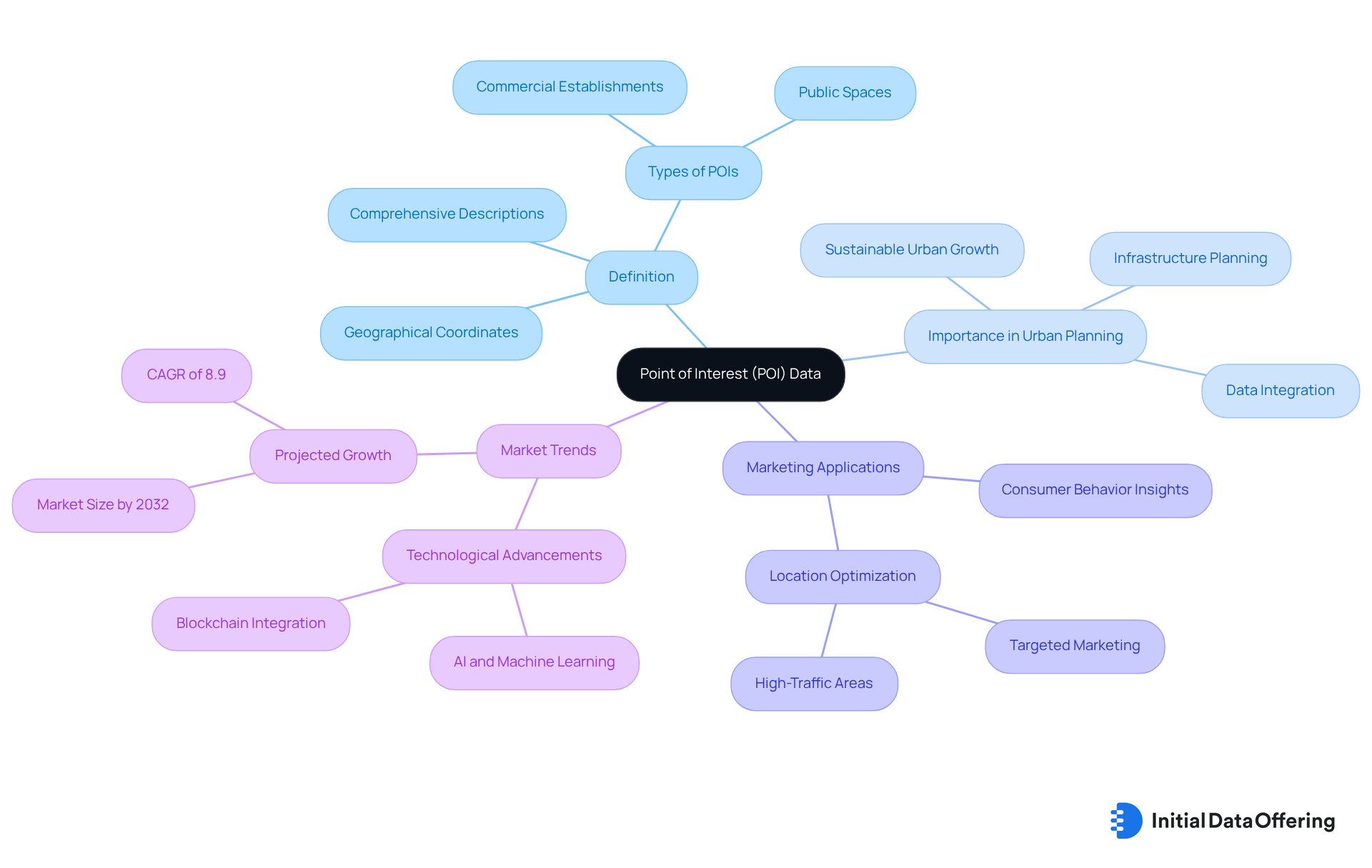
Explore Types of POI Data
Points of Interest (POI) data can be categorized into several distinct types, each serving unique analytical purposes:
- Commercial POIs: This category encompasses businesses such as restaurants, retail stores, and hotels. These are vital for understanding consumer behavior and market dynamics. Recent trends indicate a significant growth in commercial points of interest, driven by the increasing demand for [location-based services in urban areas](https://initialdataoffering.com/blog/10-data-consulting-services-to-elevate-your-market-research-strategy). Market analysts note that this growth surpasses that of public points of interest, reflecting changing consumer preferences and urbanization trends.
- Public Points of Interest: These include essential community sites such as parks, schools, hospitals, and museums. Public points of interest play a crucial role in urban planning, contributing to the quality of life and accessibility for residents. For instance, parks and recreational areas are often prioritized in city planning to enhance community well-being.
- Event-based Points of Interest: Temporary locations such as festivals, pop-up shops, and seasonal markets fall under this category. These points of interest are crucial for examining trends in consumer involvement and local economic activity during particular events. How might these temporary locations influence local economies?
- Geographic Points of Interest: This category encompasses landmarks and natural features such as mountains, rivers, and historical sites. Geographic points of interest are essential for navigation and tourism, providing context and enhancing the user experience in mapping applications. Consider how these features can attract visitors and support local businesses.
- Transportation Points of Interest: This category includes locations such as airports, train stations, bus stops, and parking lots. Transportation POIs are critical for urban mobility and planning, as they facilitate access to various services and amenities. How do these locations affect daily commutes and urban development?
Understanding what is POI is essential for analysts, as each type of of urban development and consumer insights. This understanding is vital for businesses and city planners alike, as they strategize to meet the evolving needs of urban populations.
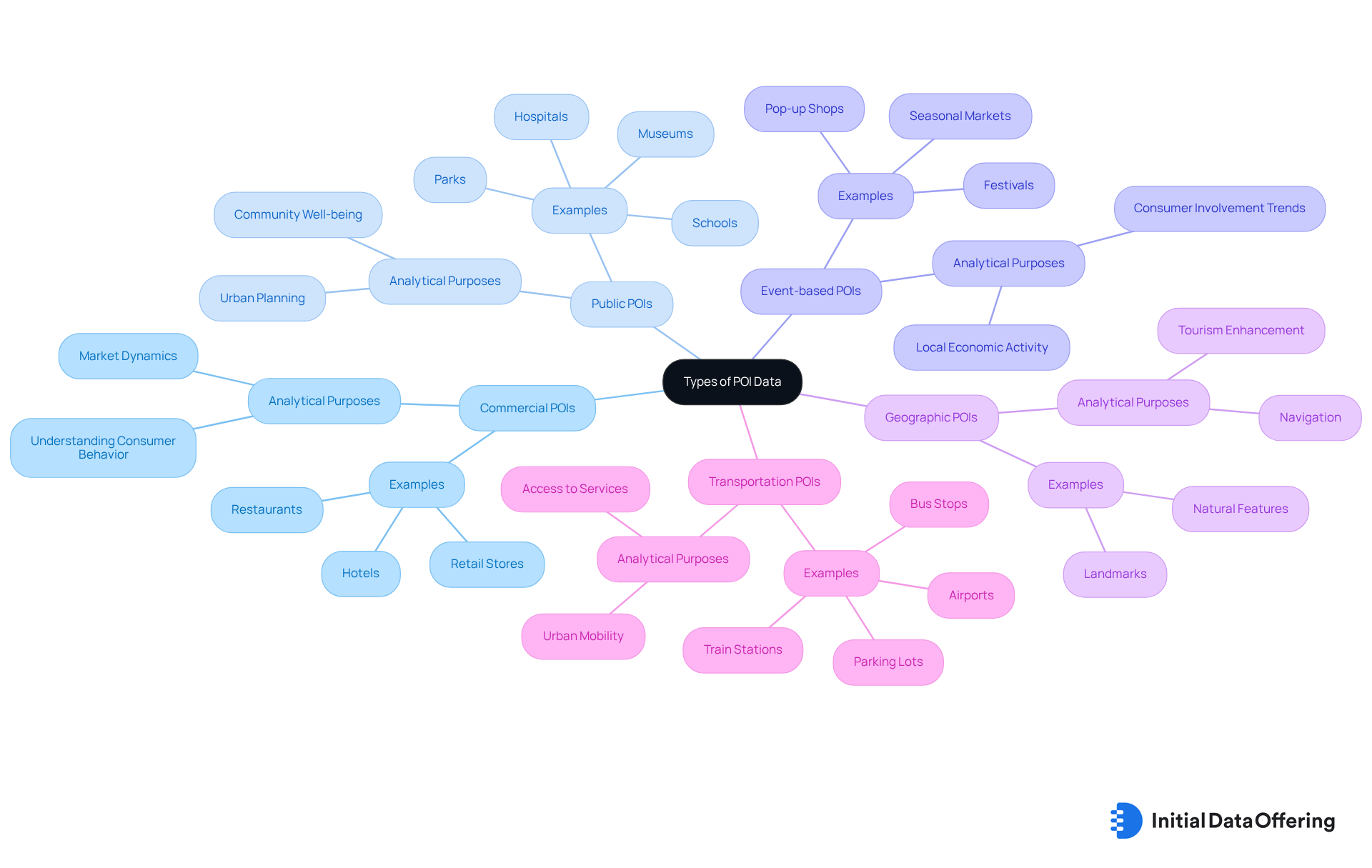
Utilize POI Data for Business Insights
Understanding what is poi data serves as a powerful tool for businesses, offering insights that can significantly enhance decision-making processes across various domains.
- Market Analysis: Mapping the distribution of competitors and potential customers allows businesses to identify strategic opportunities and threats in their target areas. Notably, 67% of marketers believe that the primary application of geographic information is for targeting, underscoring its importance in market analysis.
- Targeted Marketing: By utilizing POI information, which relates to what is poi, businesses can develop geo-targeted advertising campaigns that effectively connect with consumers based on their proximity to specific locations. This approach has proven successful, with 9 in 10 marketers reporting that location-based marketing leads to increased sales. Furthermore, 8 in 10 marketers incorporate geographical information into their marketing and advertising campaigns, highlighting its prevalence in modern marketing strategies.
- Site Selection: Site selection involves analyzing what is poi to enable businesses to identify optimal locations for new stores or services by evaluating foot traffic and nearby attractions. For instance, a leading soft drink manufacturer used POI data enhanced with sentiment analysis to inform their site selection strategy in Eastern Europe, resulting in targeted investments and improved ROI. Similarly, a coffeehouse chain applied sentiment analysis in their expansion efforts, demonstrating the versatility of POI information in site selection across various sectors.
- : Monitoring consumer interactions with different POIs yields valuable insights that can inform product offerings and marketing strategies. The growing integration of AI and machine learning in POI analytics helps businesses understand what is poi regarding customer behavior, enabling them to tailor their approaches based on real-time insights, ultimately enhancing overall engagement and satisfaction.
By effectively leveraging POI information, organizations can make informed decisions that not only improve their market positioning but also enhance operational efficiency.
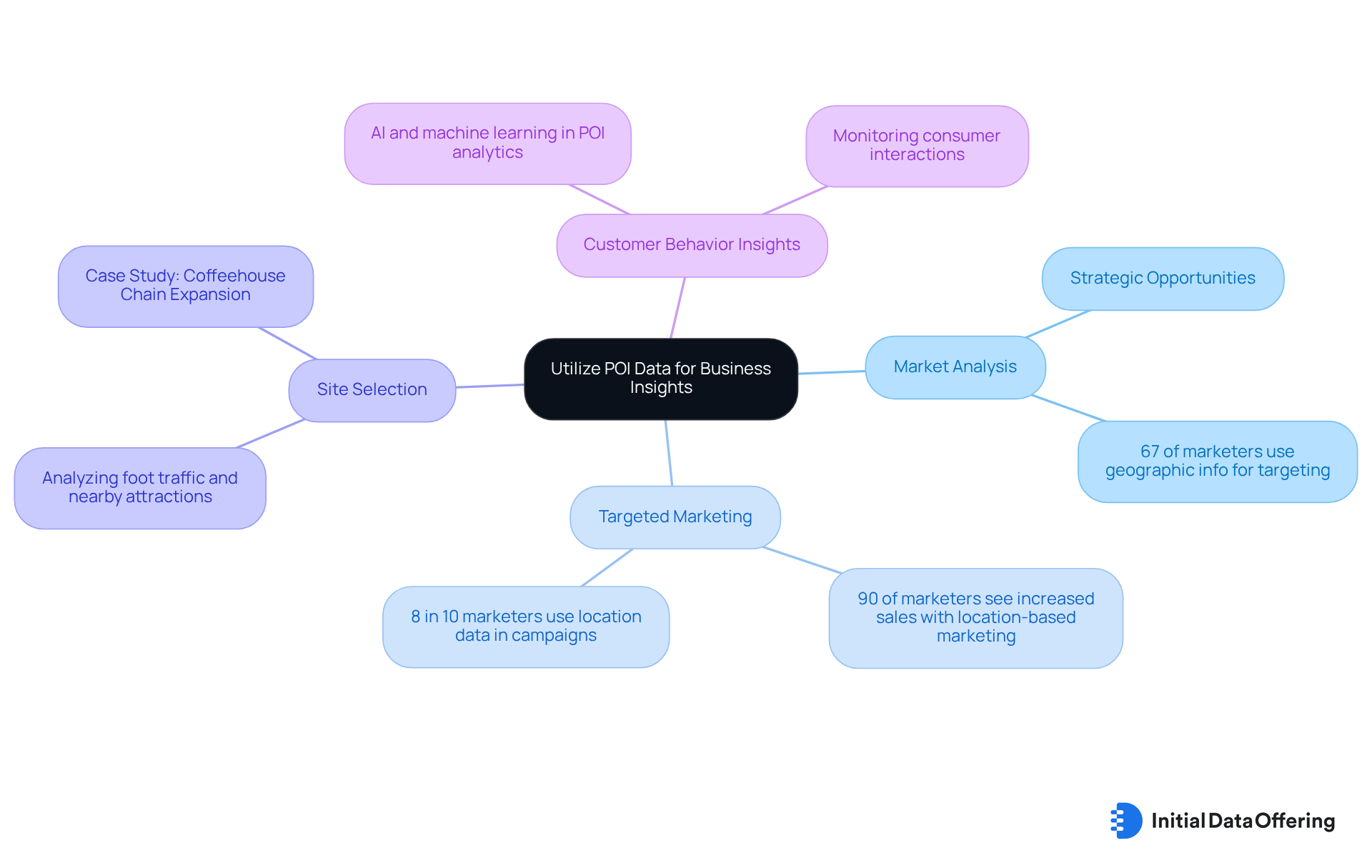
Identify Challenges in POI Data Usage
While data about offers essential insights, several challenges can impede its effective utilization.
- Data Quality: Inaccurate or outdated POI information can lead to flawed analyses and misguided decisions. The rapid changes in retail and corporate operations, particularly during the pandemic, have rendered many datasets obsolete. This highlights the need for up-to-date information, as obsolescence directly affects the precision of analyses, which raises the question of what is poi in relation to recent data.
- Information Integration: Combining POI information from various sources frequently leads to inconsistencies and fragmentation. Analysts face challenges in ensuring that the information aligns correctly, which can compromise the integrity of their evaluations. Furthermore, challenges associated with what is poi, including geolocation, spatial representation, and information fidelity, complicate this process. Approximately 1,700 new Points of Interest are added daily, yet maintaining the accuracy and relevance of this influx remains a significant challenge.
- Privacy Concerns: The use of location information raises ethical considerations regarding consumer privacy and information protection. Analysts must be vigilant in handling sensitive information to avoid potential breaches of trust. Given the significance of what is poi information in urban planning and public health, it is essential to address these privacy concerns within broader societal implications.
- Regulatory Compliance: Navigating the intricate landscape of regulations governing location-based information is crucial. Analysts must ensure that their practices align with legal standards to mitigate risks associated with non-compliance. Understanding the complexities of these regulations is vital for upholding ethical standards in information usage.
Tackling these challenges requires a strategic approach, involving regular information validation, thoughtful selection of sources, and strict compliance with legal standards. By prioritizing data quality and integration, analysts can enhance the reliability of their insights and drive better decision-making.
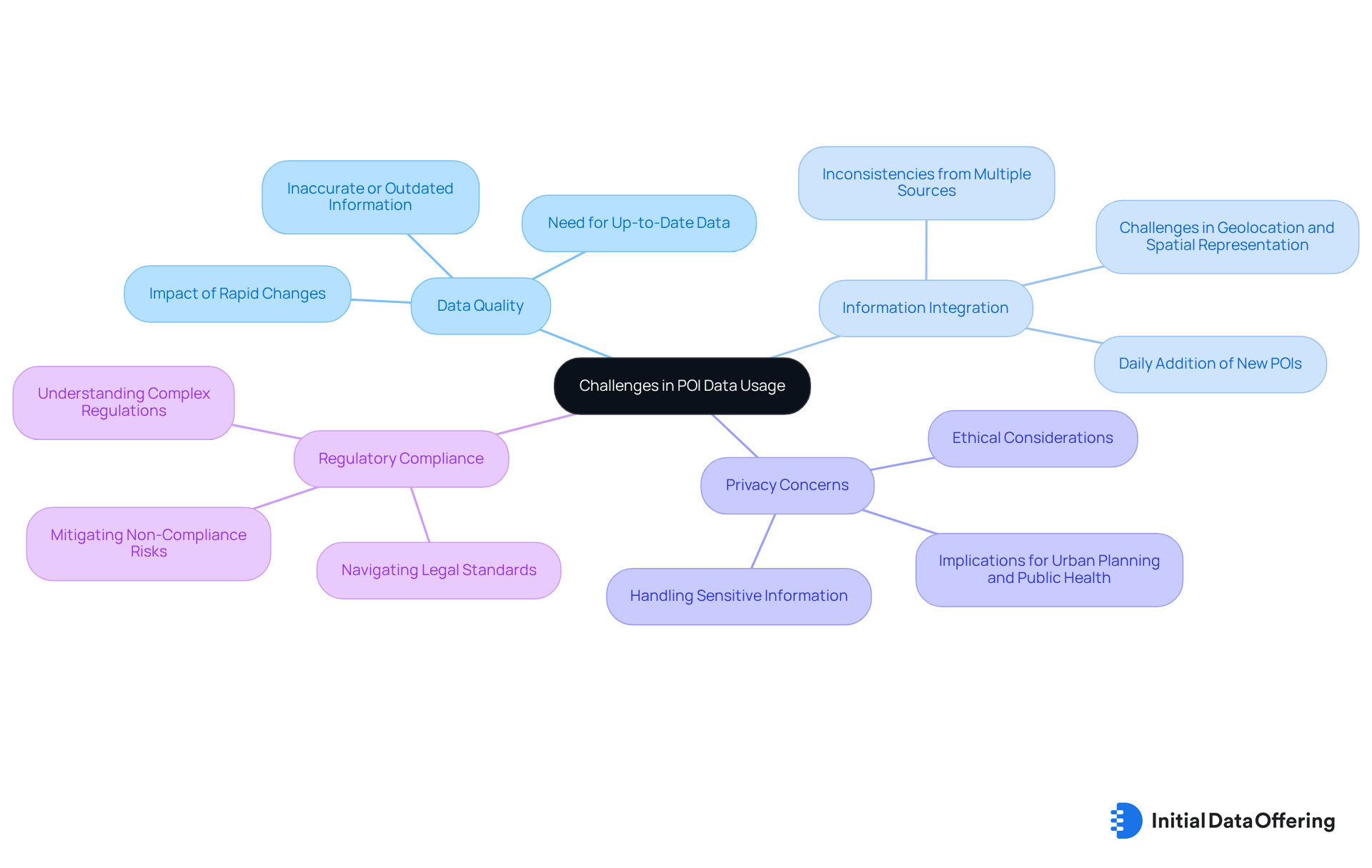
Conclusion
Understanding Point of Interest (POI) data is essential for analysts who navigate the complexities of urban environments and business landscapes. This article has explored the multifaceted nature of POI data, emphasizing its significance in urban planning, marketing strategies, and operational efficiency. By recognizing the various types of POI data—ranging from commercial and public sites to event-based and transportation points—analysts can harness this information to inform their decisions and drive growth.
Key insights highlighted include the growing importance of POI data in market analysis, targeted marketing, and site selection. The integration of advanced analytics and AI enhances the ability to monitor consumer behavior, allowing businesses to tailor their offerings effectively. However, challenges such as data quality, information integration, privacy concerns, and regulatory compliance present hurdles that must be addressed to fully leverage the advantages of POI data.
As the landscape of data continues to evolve, the importance of POI insights cannot be overstated. Analysts and businesses alike are encouraged to prioritize the accuracy and relevance of their data sources, ensuring that their strategies align with the dynamic needs of urban populations. Embracing the potential of POI data not only fosters informed decision-making but also paves the way for innovative solutions that enhance both community well-being and business success.
Frequently Asked Questions
What is Point of Interest (POI) data?
Point of Interest (POI) data refers to information about specific sites that hold significance for individuals and businesses, including geographical coordinates (latitude and longitude), names, addresses, and detailed descriptions of locations.
What types of locations can be considered POIs?
POIs can include commercial establishments like restaurants and hotels, as well as public spaces such as parks and museums.
Why has understanding POI information become more relevant in 2024?
Understanding POI information has become increasingly relevant for urban planning and marketing strategies, as it helps analysts understand spatial patterns and market dynamics essential for informed decision-making.
How do cities utilize POI information?
Cities like New York utilize POI information to enhance sustainable urban growth by integrating data related to parks, transport hubs, and businesses, which aids in infrastructure planning.
How do businesses leverage POI data for marketing?
Businesses, such as McDonald's, analyze POI data to identify high-traffic areas for new restaurant locations, optimizing their market presence and improving operational efficiency.
What impact does effective use of POI data have on business performance?
Companies that effectively utilize location insights from POI data report up to a 20% increase in performance due to improved operational efficiency.
What is the projected market value of POI information by 2032?
The POI information market is anticipated to surpass US$ 579.26 million by 2032, driven by advancements in AI and machine learning.
How does POI information assist analysts in today's data-driven landscape?
POI information helps analysts understand consumer behavior and enhances marketing strategies, making it an essential tool for effective decision-making in a data-driven environment.